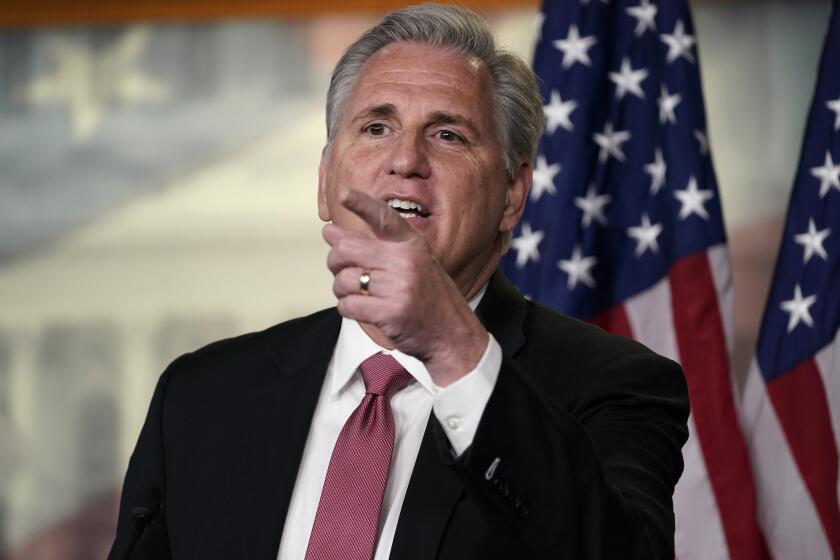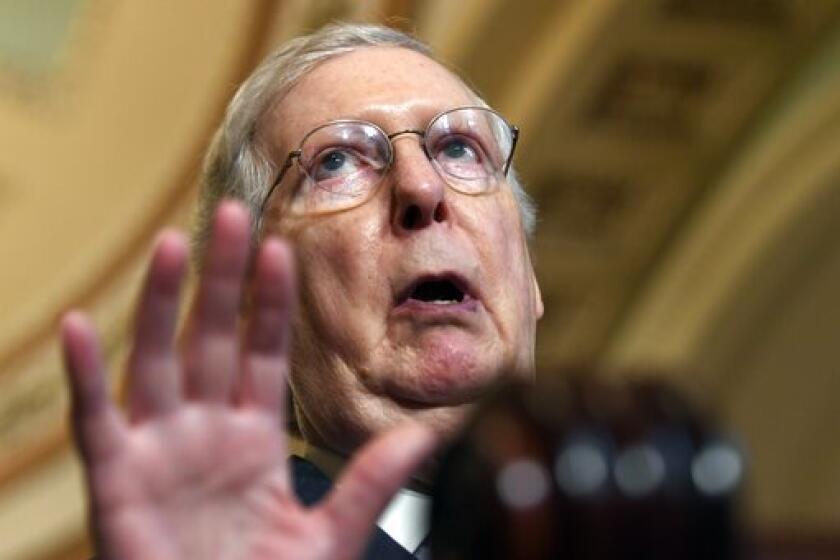Column: The omnibus bill will help you save for retirement, though Wall Street will get its cut

- Share via
The average American’s path to retirement security has long been a steep uphill climb. The omnibus spending bill President Biden signed on Dec. 29 will make the journey easier.
The $1.7-trillion bill will add access to workplace retirement plans for workers who haven’t had many options and increase their incentives for funding workplace accounts, including through an unprecedented tax benefit.
The omnibus bill is far from perfect; many of its positive provisions fell short of advocates’ hopes and expectations.
Mega-IRAs...are a problem primarily caused by laws that lavish excessive tax benefits on high-income individuals.
— Daniel Hemel and
The measure includes a $785-million increase in the operating budget of the Social Security Administration, for example — but that’s “just enough for SSA to tread water,” as Max Richtman, chief executive of the National Committee to Preserve Social Security and Medicare, put it.
The appropriation won’t allow the Social Security Administration to significantly reduce a huge backlog in disability claims and adjudications, or to “significantly improve diminished customer service,” Richtman observed.
Get the latest from Michael Hiltzik
Commentary on economics and more from a Pulitzer Prize winner.
You may occasionally receive promotional content from the Los Angeles Times.
The same mix of cheer and disappointment surrounds Secure 2.0, the individual retirement package in the omnibus package.
To the extent that they improve access and tax advantages to middle- and lower-income workers, these provisions are important because federal retirement laws and tax breaks traditionally have been heavily skewed toward the wealthy.
Higher-income workers generally have far more disposable income than average Americans to invest in retirement accounts, and their higher incomes raise the value of the tax advantages that come with individual retirement accounts and defined contribution plans such as 401(k) accounts.
That’s evident from government statistics. According to the Congressional Budget Office, about 77% of households in the top fifth of the income ladder benefited from tax breaks for pension and retirement accounts, chiefly deductions for contributions and tax-exempt investment growth; only 19% of households in the lowest fifth did so.
(In 2019, the top fifth comprised households with annual income higher than $142,500, with the average within the segment collecting more than $254,000. The lowest fifth comprised households with income of less than $28,084, averaging $15,286.)
Politicians continually portray tax-advantaged retirement plans as boons for the middle- and working class, but that’s contradicted by reality, as Daniel Hemel of NYU law school pointed out last year after the congressional Joint Committee on Taxation revealed that almost 29,000 U.S. taxpayers had accumulated retirement accounts worth $5 million or more.
That would be almost impossible to do unless one could max out his or her tax-advantaged contributions over a career of 30 years or more. “Mega-IRAs,” observed Hemel and Steve Rosenthal of the Tax Policy Center, “are a problem primarily caused by laws that lavish excessive tax benefits on high-income individuals.”
Investment promoters are pushing people to add cryptocurrencies to their retirement plans. Here’s why that’s a lousy idea.
Of the three traditional legs of the retirement stool, conventional pensions have disappeared and ordinary Americans have found it ever more difficult to save for retirement on their own. Social Security has maintained its importance for tens of millions of households in or nearing retirement, but it was never expected to be seniors’ sole support.
That underscores the value of some of the provisions of Secure 2.0.
To begin, Secure 2.0 requires employers already offering defined contribution plans such as 401(k) and 403(b) plans to automatically enroll new workers into the plans, starting at with 3% of the workers’ wages in 2025 and increasing by a single percentage point each year until it reaches 10%.
In effect, this changes the default for new employees to an opt-out rather than an opt-in decision. Studies have consistently found that opt-out rules increase the proportion of new workers who open and fund their accounts. Secure 2.0 makes worker participation entirely voluntary — they can refuse to make a contribution, reduce it or close their account at any time.
Earlier versions of the Secure Act, including a version in Biden’s 2021 “Build Back Better” program, would have required almost all employers to offer defined contribution plans to employees, but that was dropped in favor of imposing the opt-out default and minimum contribution to new plans or new employees joining employers with existing plans.
Another provision concerns the contribution match that many employers make for workers participating in their defined contribution plans — typically up to 4% or 6% of the employees’ wage rates.
Under Secure 2.0, employers can choose to match employees’ student loan payments, starting in 2024. In effect, that would subsidize the loan payments by allowing workers to start a retirement savings fund while still paying off their student debt. (Employers receive a tax break for matching contributions.)
Republican leaders are threatening to take the debt limit hostage unless they get Social Security and Medicare benefit cuts.
Secure 2.0 also enhances a tax credit offered to low-income participants in retirement plans, including IRAs and 401(k) plans. The existing credit is 50% of the saver’s contribution, up to $1,000; it phases out this year to a maximum income of about $36,500 for singles and $73,000 for married couples filing jointly. The savers credit is “nonrefundable,” however, meaning that it can’t exceed a taxpayer’s federal income tax.
Secure 2.0 makes the credit refundable starting in 2027, meaning that it will be paid even if the worker doesn’t owe any federal income tax.
The savers credit and other provisions of the new law will be good for residents of states with their own mandated retirement programs for low-income workers, including California and Illinois. In California, starting in 2022, employers with more than five workers were required either to offer a qualified retirement plan or enroll their employees in CalSavers, a state-sponsored program, with a default contribution rate of 5% of wages.
Employees can change their savings rate or leave the program at any time; the available investments include target funds that allocate investments based on the participant’s age and expected retirement date, general bond or stock funds, green investment funds, or a money market fund.
One sin of omission in Secure 2.0 is the absence of an option for savers to invest their money with the Thrift Savings Plan, a low-cost program open only to federal employees and members of the armed forces and reserves. The Thrift plan has six fund options, all with rock-bottom fees.
Instead, investors are left with options offered by Wall Street money managers that can carry fees as much as 20 times higher than the Thrift average, in the estimation of economist Dean Baker of the Center for Economic and Policy Research.
“While it is great that workers will have more savings for retirement,” Baker observed after passage of the omnibus measure, “this bill can mean big money for the financial industry.”
One other aspect of the omnibus bill is largely a handout to professional money managers. These are changes in the rules governing required minimum distributions, or RMDs, from tax-advantaged retirement accounts.
Improving Social Security is a matter of political will, not affordability.
The prior rules required that owners of those accounts start withdrawing money from their accounts starting no later than age 72, with the mandated withdrawals based on the size of the accounts and the owner’s life expectancy.
The new rules defer the starting age to 73 this year and 75 starting in 2033. That means the money could remain invested with private money managers for longer, which is obviously good for the firms.
The change, moreover, largely benefits more affluent retirees who can afford to leave their money in investment accounts for longer instead of taking it out for living expenses.
There’s one key qualification of that benefit, however: Some retirees may prefer to leave their funds invested for a longer period because withdrawals are treated as income for the purpose of calculating annual Medicare premiums — the higher the income, the higher the premium.
It’s likely that allowing the private financial services industry to remain deeply entrenched in our retirement system was necessary to get Secure 2.0 passed, given its lobbying clout in Washington — in the same sense that keeping the health insurance industry at the center of our healthcare system was a key to enacting the Affordable Care Act in 2010.
Extricating the retirement assets of most working Americans from Wall Street’s grasp won’t be easy. Congress and the Biden White House may have accomplished the next best thing, by giving those workers a better shot at building a retirement nest egg. They still won’t have all the advantages of the rich, but at least they’ll have more than they did a year ago.
More to Read
Get the latest from Michael Hiltzik
Commentary on economics and more from a Pulitzer Prize winner.
You may occasionally receive promotional content from the Los Angeles Times.














